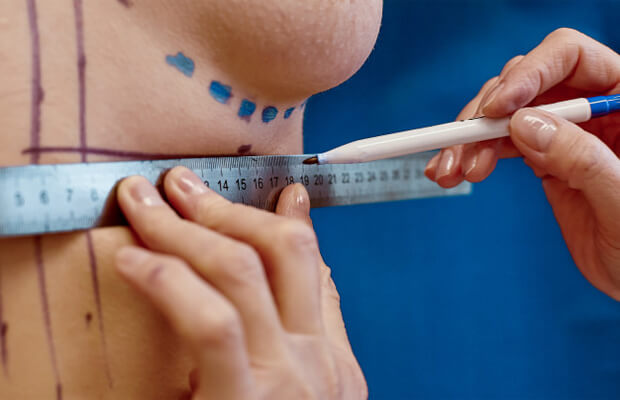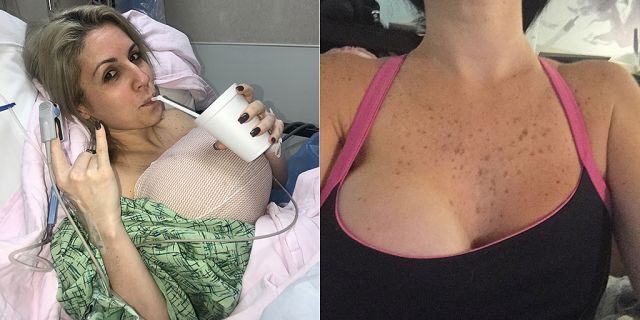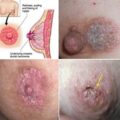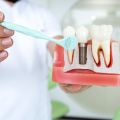About 22,000 implants were removed because of problems in 2010, according to the American Society of Plastic Surgeons (ASPS). But that hasn’t put a crimp in women’s desire for them. That same year, there were nearly 300,000 breast augmentation procedures, up to 39% from 2000. About a third, or 93,000, were reconstructions for cancer patients.
Tens of thousands of women worldwide are claiming to suffer from ‘Breast Implant Illness’ (BII), with complaints ranging from brain fog, hair loss, fatigue, Irritable Bowel Syndrome, headaches, photosensitivity, chest pain, sleep disturbance and autoimmune diseases such as lupus and fibromyalgia, a long-term condition that manifests as chronic pain all over the body. Despite this, BII is not yet an official medical diagnosis, though medical professionals and administrators are now calling for more research into the negative effects of breast implants — especially with recent reports linking them to an increased risk of developing lymphoma, a kind of cancer.
For fitness instructor Naomi Macarthur who got implants in 2014, BII manifested with the “most horrific symptoms” including blinding pain in her stomach. “And the tiredness was like I had run a marathon and dug a million trenches but I hadn’t done anything.… Writing with a pen was too tiring,” she said, speaking to the BBC.
The decision to have breast implant removal surgery is dependent on many factors, including your overall health, if the implant is leaking, if the implant has ruptured and your personal desire. You’ll have to decide if the benefits will achieve your goals and if the risks and potential complications of breast implant removal are acceptable.
How do I know if my breast implants are in trouble?
According to Dr Lily Vrtik there are symptoms and signs that may indicate problems associated with breast implants. However, one must always remember that majority of implant ruptures are picked up incidentally on ultrasounds and mammograms. On the other hand, some of the symptoms and signs mentioned below may not be due to the breast implant, but rather possible disease within the breast tissue itself.
Breast pain, breast discomfort, nipple sensitivity and soreness are not uncommon presenting complaints from patients with breast implants. Many attribute it directly to the implants but one must remember, idiopathic (unknown medical cause) breast and nipple pain is actually a very common phenomenon in women in general. If the discomfort is not associated with hardening, shifting or changes in the implant shape, a simple ultrasound or MRI can provide reassurance that the implant is intact, and may also allow detection of any abnormal breast tissue overlying the implant.
Breast lumps are often a concerning feature in patients with or without breast implants. In patients with old liquid silicone implants, pockets of silicones which has seeped into the breast tissue can form hard lumps. These can be detected and differentiated from breast cancer lumps via imaging techniques such as ultrasound, mammogram and MRI.
Change in breast shape or progressive asymmetry between the two breasts. Breast implants can move on the chest wall, or capsular contracture can push an implant upwards. This often occurs slowly overtime, thus can be difficult for some to notice. However, if you find that your bra sits crooked because your breasts are not at the same level, or if it doesn’t fit because one is sitting a little further into the armpit, then it may be time to see your doctor or a plastic surgeon. Don’t forget, sometimes pre-existing natural breast asymmetry can become more obvious after weight changes or even hormonal fluctuations such as pregnancies or menopause. This means, you may need a change in the size of your implants to correct the difference between the two sides.
Breast swelling is very rarely associated with breast implants. This can be associated with trauma to the chest wall (you may have bled around the implant), or it may be spontaneously with no precipitating event. The former requires urgent surgery, the latter requires further investigations into the cause of the swelling. Swelling can be due to fluid around the implant or infection. Swelling can sometimes be associated with abnormality in the breast tissue and need to be thoroughly assessed.
Breast skin or nipple discharge need to be taken seriously. If there are any discharge from an open sore on the breast or the nipple, please see your doctor. This could be implant-related or associated with diseases of the breast tissue or nipple, which may not necessarily be cancer.
The World Health Organization and the U.S. Food and Drug Administration have identified another possible cause for concern. This relates breast implants to a rare cancer called breast implant-associated anaplastic large cell lymphoma (BIA-ALCL).
Breast Implants Gone Wrong!!!!
Angelica Isaksen, from Stockholm, a mother-of-two’s breast implant fell out of her chest weeks after botched surgery in Turkey. The 27-year-old – desperate to get her body back in shape for bikini competitions – claims she chose the unnamed clinic after seeing celebrities promote it on the social media site according to the daily mail.
There are many other side effects like capsular contracture and leakage on the implants and it might mean that the surgery is unsuccessful and you will face a lot of inconvenience after the surgery. Therefore, if you don’t want to face these kinds of risks, you should select an experienced and skilled surgeon who will help you in getting the best results from the surgery.
How can you prevent a breast implant problems and illness?
The survival rate for people with BIA-ALCL is relatively high at 89 percent at 5 years, in general for any stage of this cancer. The survival rate is even higher for people with stage 1 cancer who have a complete removal of their affected implant or implants and cancerous breast tissues.
However, cancer treatment is challenging, expensive, and not always effective. Although there are risks associated with breast augmentation, it’s still considered a safe procedure. Before your procedure, make sure you understand your risks for complications. Keep in mind that the risk for BIA-ALCL is exceedingly rare.
Regarding the risk for autoimmune disease, recent research shows an association with breast implants, silicone in particular. However, the conclusiveness of the data is controversial and will likely require further studies to more specifically investigate and pinpoint a definite direct cause-and-effect relationship.
To minimize your risk for infection, implant rupture, and breast cancer illness, closely monitor your breasts after your procedure. Follow your surgeon’s aftercare instructions closely. See your doctor right away if you notice any changes in your breasts or health, especially if you experience signs of infection. SEE: Why Do My Breasts Sag At A Young Age









